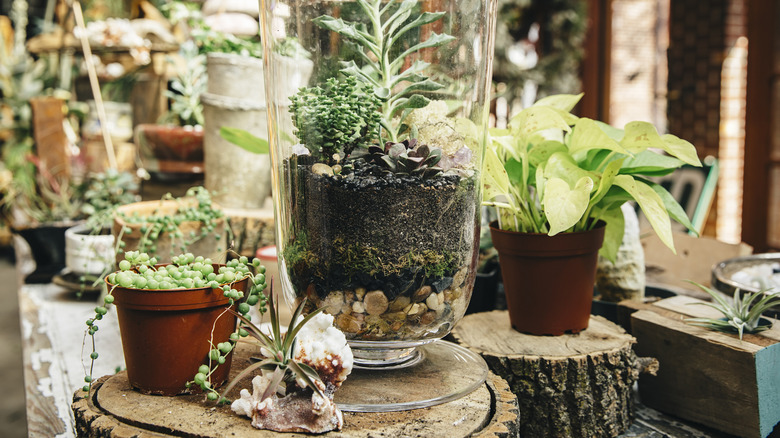Martha Stewart Reveals A Clever Trick For Reusing Stumps From The Garden
We may receive a commission on purchases made from links.
In a recent blog post, Martha Stewart revealed a clever trick for reusing stumps from the garden, as she and thousands of other gardeners are thinking about plants that need to be overwintered before temperatures start dropping. In Stewart's case, those plants include a huge variety of tropicals like bird's nest fern (Asplenium nidus) and sago palms (Cycas revoluta) that prefer warmer temperatures. After carefully examining her plants, removing damaged or rotting leaves, and repotting them as necessary (you can use something similar to Miracle-Gro Indoor Potting Mix for Houseplants), she and her staff move them into temperature-controlled hoop houses. Stewart repurposes stumps from downed trees as plant risers and for legs of the tables that hold her prized plants.
As extreme weather events occur more frequently, many of us must figure out what to do with fallen trees in our yards. In 2020, when Stewart's farm was impacted by Tropical Storm Isaias, her crews chipped most of the fallen trees and branches, putting them directly back into her woodland where they could decompose slowly over time, improving the soil. Some of the larger logs were repurposed as milled lumber or firewood.
Woodland maintenance is a regular task at Stewart's Bedford, New York farm. "My crew amasses quite a large pile of organic materials – bark, stumps, logs, and brush," she wrote on The Martha Blog. "If all is...repurposed...Nothing goes to waste."
Tips for using tree stumps to safely overwinter potted plants
There are many creative ways to repurpose an old tree stump in your yard. Using tree stumps as plant risers, either in an outdoor greenhouse or inside a sunroom, is an inexpensive way to display houseplants at varying heights without the expense of purchasing several small side tables or commandeering your dining or kitchen table all winter long. Unlike storing plants on a table, where they may get jammed together, stumps also allow you to spread out your potted plants so they have adequate air circulation and don't touch each other.
There are several reasons to separate your plants. Along with an increased risk of spreading pests from one pot to another, research published in The Plant Journal suggests that even a slight touch can activate a plant's defense response, slowing down growth and altering its genome. Overwintering your potted plants too closely can also make them compete for sunlight, which also can cause stress and damage.
There are many things to consider before removing a tree stump from your yard. Stump removal can be costly, dangerous, and difficult. Carefully cutting fallen or felled trees into one- to two-foot sections using a tool like the Dewalt DCCS620B 20V MAX XR Brushless Lithiom-Ion 12-inch Compact Chainsaw can help you get the same natural plant stand look without the hassle of digging up and drying out an actual stump.

